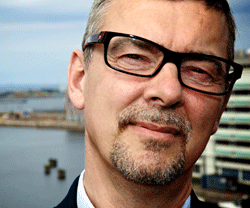Closed Loop Marketing: Where Next?
Morten Hjelmsoe offers a quick review of the development of our communication technologies- and looks forward to what’s coming next.
Morten Hjelmsoe offers a quick review of the development of our communication technologies- and looks forward to what’s coming next.
We started out taking our paper materials – our detail aids and brochures – and digitizing them. This meant that we could transport things easier but also enabled a bit of interactivity – charts would move, animations could play.

Morten Hjelmsoe
This was OK, but not really very smart. So the next step was to add some intelligence – a CRM backend to the system.
This enabled us to do some limited tracking. It was limited because it only measured message delivery – you could see what was said but learned nothing about what was actually received. And to get even this limited data, our sales force had to keep heading back to base and plugging in their devices (laptops in the early days).
To solve that, the systems went ‘into the cloud’. This kept the reps on the road. But the systems still weren’t very user friendly or appropriate to the life sciences business. So then we get a ‘pharma layer’ added to these systems.
This was fine, but basically was still CRM, so it could still only really track what we said and not what our customers thought of it. And that brings us to today.
The arrival of real CLM means that we can finally start to understand what our customers thought about our communications.
It’s interesting to me that, as we went through this technology development process, something really important emerged. Have a read back and you’ll see what there was a fundamental shift in focus from us to our customers. So rather than build a system around what suits us, we can now shape our communications around our customers.
It’s a revolution. The very best CLM technology places the customer at the center of a web of multichannel communications that that they drive. This switch from ‘push’ to ‘pull’ really is revolutionary because it means that we’re working on an individual level.
So – following a little bit of discovery – we can understand what each customer needs to know and how we can help him or her. It not only takes the guesswork out of marketing but also removes antagonism from our customer outreach.
So that’s where we are today – quietly going about a pretty fundamental revolution.
So what then about tomorrow?
The next step – and one that we can take very soon – is to empower the same process between the doctor and the patient. The industry’s shift ‘beyond the pill’ necessarily draws us further into the treatment process: creating new demands and responsibilities. But it’s not about replacing medical professionals. The very CLM technology that placed doctors in the centre of our communication can keep them there when they interact with their patients.
So for the future, we just need to expand our understanding of what the technology can do. Exciting times ahead!
Morten Hjelmsoe is the CEO and founder of Agnitio.
Addressing Disparities in Psoriasis Trials: Takeda's Strategies for Inclusivity in Clinical Research
April 14th 2025LaShell Robinson, Head of Global Feasibility and Trial Equity at Takeda, speaks about the company's strategies to engage patients in underrepresented populations in its phase III psoriasis trials.
Beyond the Prescription: Pharma's Role in Digital Health Conversations
April 1st 2025Join us for an insightful conversation with Jennifer Harakal, Head of Regulatory Affairs at Canopy Life Sciences, as we unpack the evolving intersection of social media and healthcare decisions. Discover how pharmaceutical companies can navigate regulatory challenges while meaningfully engaging with consumers in digital spaces. Jennifer shares expert strategies for responsible marketing, working with influencers, and creating educational content that bridges the gap between patients and healthcare providers. A must-listen for pharma marketers looking to build trust and compliance in today's social media landscape.
Pfizer, GSK Gain ACIP Recommendations for RSV and Meningococcal Vaccines
April 18th 2025The Centers for Disease Control and Prevention’s Advisory Committee on Immunization Practices voted to expand access to Pfizer’s respiratory syncytial virus vaccine Abrysvo for high-risk adults in their 50s and voted in favor of GSK’s meningococcal vaccine, Penmenvy, for streamlined adolescent protection.